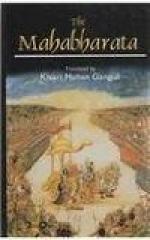143. How the world has been likened to a tree has been explained in the Moksha sections of the Santi Parvan.
144. This is explained in the sense of no one being able to enquire after Brahman unless he has a body, however subtile, with the necessary senses and understanding. It may also mean that the tree of the world furnishes evidence of the existence of the Supreme Deity.
145. Both the vernacular translators have rendered many of these names most carelessly. The Burdwan translator takes Yaju as one name and Padabhuja as another. This is very absurd.
146. These are the ten previously enumerated, beginning with residence in the mother’s womb and ending with death as the tenth, with heaven the eleventh and Emancipation the twelfth.
147. It should be remembered that Kali which is either the age of sinfulness or the presiding deity of that age and, therefore, a malevolent one, is highly propitious to Emancipation. The world being generally sinful, those who succeed in living righteously in this age or under the sway of this malevolent deity, very quickly attain to heaven if heaven be their object, or Emancipation if they strive for Emancipation.
148. Implying that thou assumest the form of the constellation called the Great Bear, and moving onward in space causest the lapse of Time. This constellation, in Hindu astronomy, is known by the name of Sisumara because of its resemblance with the form of a tortoise.
149. The word bhashma, meaning ashes, literally signifies anything that dispels, tears off all bonds, and cures every disease. Ashes are used by Sanyasins for rubbing their bodies as a mark of their having consumed every sin and cut off every bond and freed themselves from all diseases.
150. Mahadeva gave a quantity of ashes to his devotees for protecting them from sin.
151. Vide the story of Mankanaka. The Rishi of that name, beholding vegetable juice issuing from his body, began to dance in joy. The whole universe, overpowered by a sympathetic influence, began to dance with him. At this, for protecting the universe, Mahadeva showed himself to Mankanaka and, pressing his fingers, brought out a quantity of ashes, thus showing that his body was made of ashes.
152. Anukari literally means an accessory. In the form of Vishnu or Krishna, the Supreme Deity addrest himself to aid Arjuna in slaying Bhishma.
153. As Krishna the friend of Arjuna.
154. In the Pauranik myth, the Earth is described as being supported in empty space by a mighty snake called Sesha. Mahadeva is that Sesha, otherwise called Ananta.
155. i.e., Mahavishnu, from whose navel arose the primeval lotus within which was born Brahma.
156. The Bombay text has a misprint. It reads Punya-chanchu for Punya-chunchu. In printing the commentary also, the well-known grammatical Sutra vrittanschanchu etc. The Burdwan translator repeats the misprint in his rendering. K. P. Singha avoids it.




